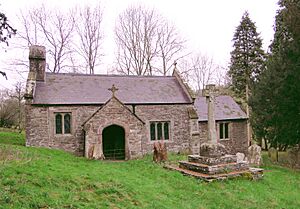Llancillo Church facts for kids
Llancillo Church is a very old church in Herefordshire, England, located near the border with Wales. It is a Grade II*-listed building. This special status means it is a particularly important historic site that must be protected.
The church, which is also spelled Llancilo, is surrounded by trees and fields. It was dedicated to Saint Peter or sometimes to a Welsh saint named St Tysilio. The oldest parts of the church were built in the 11th century. It has been repaired and changed over the centuries.
Today, Llancillo Church is a redundant church. This means it is no longer used for regular weekly worship services. Instead, it is cared for as a historical treasure. Inside, you can find special items like a font from the 1200s and a pulpit from the 1600s.
Contents
History of the Church
Early Beginnings
It is believed that the church's story began in the 6th century. A hermit, a person who lives alone for religious reasons, may have first used this quiet spot. The oldest part of the current building, the chancel (the area around the altar), dates back to the 11th century.
Much of the church was rebuilt in the 17th century. Later, during the reign of Queen Victoria, it had a major restoration in the 1890s.
A Church on the Border
Even though Llancillo Church is in England, it has strong connections to Wales. For a very long time, it was part of the Welsh Diocese of St David's. A diocese is an area managed by a bishop. In 1852, the church was officially transferred to the English Diocese of Hereford.
A New Chapter
On December 22, 2006, the church was closed for regular services. In 2007, a charity called the Friends of Friendless Churches took over its care. This group works to protect and repair historic churches that are no longer in use.
What to See at the Church
Building and Design
Llancillo Church is built from a type of rock called sandstone and has a roof made of slate. It has two main parts: a smaller chancel and a larger nave, which is the main area where people would sit. There is also a small porch on the south side of the building.
On the roof is a small structure called a bellcote that holds the church bells. One of the bells is thought to be very old, possibly made in the 13th century or even earlier.
Historic Treasures Inside
- Baptismal Font: The stone font, used for baptisms, is from the 13th century.
- Pulpit: The wooden pulpit, where sermons were given, was made in 1632.
- Doorway: The church has a doorway built in the Tudor style.
In the Churchyard
Outside the church, you can see the remains of a stone cross from the 14th century. This was a "preaching cross," where sermons could be given outdoors.
Nearby, there is a large mound of earth. This is what is left of a motte castle, a type of fortress built on a hill.


